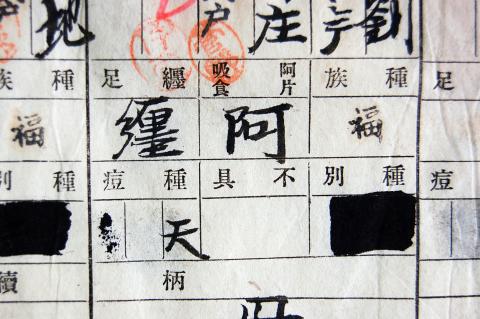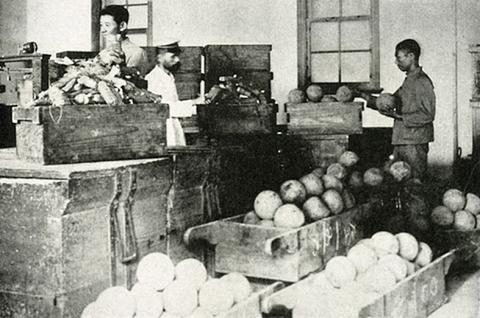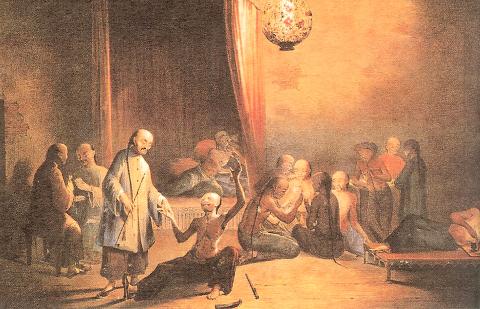Jan. 15 to Jan. 22
Japanese prime minister Ito Hirobumi declared war on opium in Taiwan on April 10, 1895, declaring that the colonial government would be able to “quickly eradicate” the widespread vice in their soon-to-be-acquired territory.
That day was the fourth negotiation between the Qing and Japanese empires, as Li Hongzhang (李鴻章) made a final attempt to dissuade Japan from taking over Taiwan by emphasizing the long-standing habit among its inhabitants.

Photo: Chen Chin-min, Taipei Times
“There have been people living in Taiwan long before the arrival of opium,” Ito replied. “We will strictly prohibit the import of the drug, and nobody in Taiwan will be able to smoke.”
When Li warned Ito that such measures might lead to unrest, Ito replied, “That will be the Japanese Empire’s responsibility.”
Han Chinese settlers in Taiwan had been smoking opium for centuries by then — a Qing Dynasty report from 1724 condemned the practice, stating that it was a vice that needed to be curbed immediately.

Photo courtesy of Wikimedia Commons
But the habit only became more widespread, especially after the Opium Wars in China, which led to the forced legalization of the drug in 1860. Liu Ming-hsiu (劉明修) writes in the book Ruling Taiwan and its Opium Problem (統治台灣與鴉片問題) that between 1864 and 1881, the amount of legal opium imported into Taiwan each year increased from 59,820kg to 352,843kg. And by 1892, the opium trade accounted for more than half of Taiwan’s total revenue.
During the Japanese invasion of Taiwan, resistance leaders even fabricated a Japanese-issued opium prohibition edict to rally addicts to join their ranks, Liu writes. In response, the government temporarily allowed Taiwanese to continue smoking while making it punishable by death to supply the drug to Japanese troops, and later all Japanese nationals.
After the resistance fell in late 1895, the great debate began between proponents of immediate and gradual prohibition. The immediate prohibition camp was mainly concerned that the opium habit would spread to Japan if not curbed right away.

Photo courtesy of Wikimedia Commons
The gradual camp countered by stating that Japanese were not likely to become addicts because of their proclivity to alcohol, which did not mix well with opium. This claim was widely accepted. They also proposed a government monopoly over the manufacturing and sale of opium. Although the government claimed that it chose this path out of benevolence, Liu writes that the real reasons were to avoid further conflict with Taiwanese and also to boost government revenue.
On Jan. 21, 1897, the Japanese colonial government issued the Taiwan Opium Edict, which established the government monopoly and restricted purchase to “proven addicts” with special licenses, with no new licenses issued. In addition, all vendors and users would have to pay a usage fee to the government. Violators were either sent to jail or fined.
There was no verifiable method to show that one was an addict, and Liu writes that essentially anyone over 20 years old who applied would likely have their license approved.
The process took three years because of continued armed resistance, epidemics and people unwilling to pay the usage fee. When the government declared the process complete and cut off registration, there were 169,064 license holders.
However, Liu writes that while legal opium users decreased over the years, the number of illegal users only increased. In 1908, the government launched a mass raid, arresting more than 17,000 illegal users. However, 15,863 of them were deemed “incurable addicts” and given licenses instead.
It was a lucrative venture for the government, as opium revenue accounted for as high as 46.3 percent of the colony’s total in 1898, according to statistics found in Liu’s book. As the number of legal users dropped, the government tried to export the opium and turn it into morphine. They also increased the prices yearly.
During the 1920s, Taiwan’s intellectual elite accused the government of delaying the eradication process so they could keep making money. After repeated protests, they took the issue to the League of Nations, upon which the government started implementing treatment programs and facilities for addicts.
However, the colonial government never relinquished their monopoly, only ceasing to produce the drug in 1944 when opium poppies were needed to make anesthesia during World War II. And they never stopped selling until June 1945 — just two months before surrender.
Taiwan in Time, a column about Taiwan’s history that is published every Sunday, spotlights important or interesting events around the nation that have anniversaries this week.

Exceptions to the rule are sometimes revealing. For a brief few years, there was an emerging ideological split between the Democratic Progressive Party (DPP) and Chinese Nationalist Party (KMT) that appeared to be pushing the DPP in a direction that would be considered more liberal, and the KMT more conservative. In the previous column, “The KMT-DPP’s bureaucrat-led developmental state” (Dec. 11, page 12), we examined how Taiwan’s democratic system developed, and how both the two main parties largely accepted a similar consensus on how Taiwan should be run domestically and did not split along the left-right lines more familiar in

This month the government ordered a one-year block of Xiaohongshu (小紅書) or Rednote, a Chinese social media platform with more than 3 million users in Taiwan. The government pointed to widespread fraud activity on the platform, along with cybersecurity failures. Officials said that they had reached out to the company and asked it to change. However, they received no response. The pro-China parties, the Chinese Nationalist Party (KMT) and Taiwan People’s Party (TPP), immediately swung into action, denouncing the ban as an attack on free speech. This “free speech” claim was then echoed by the People’s Republic of China (PRC),

As I finally slid into the warm embrace of the hot, clifftop pool, it was a serene moment of reflection. The sound of the river reflected off the cave walls, the white of our camping lights reflected off the dark, shimmering surface of the water, and I reflected on how fortunate I was to be here. After all, the beautiful walk through narrow canyons that had brought us here had been inaccessible for five years — and will be again soon. The day had started at the Huisun Forest Area (惠蓀林場), at the end of Nantou County Route 80, north and east

Specialty sandwiches loaded with the contents of an entire charcuterie board, overflowing with sauces, creams and all manner of creative add-ons, is perhaps one of the biggest global food trends of this year. From London to New York, lines form down the block for mortadella, burrata, pistachio and more stuffed between slices of fresh sourdough, rye or focaccia. To try the trend in Taipei, Munchies Mafia is for sure the spot — could this be the best sandwich in town? Carlos from Spain and Sergio from Mexico opened this spot just seven months ago. The two met working in the